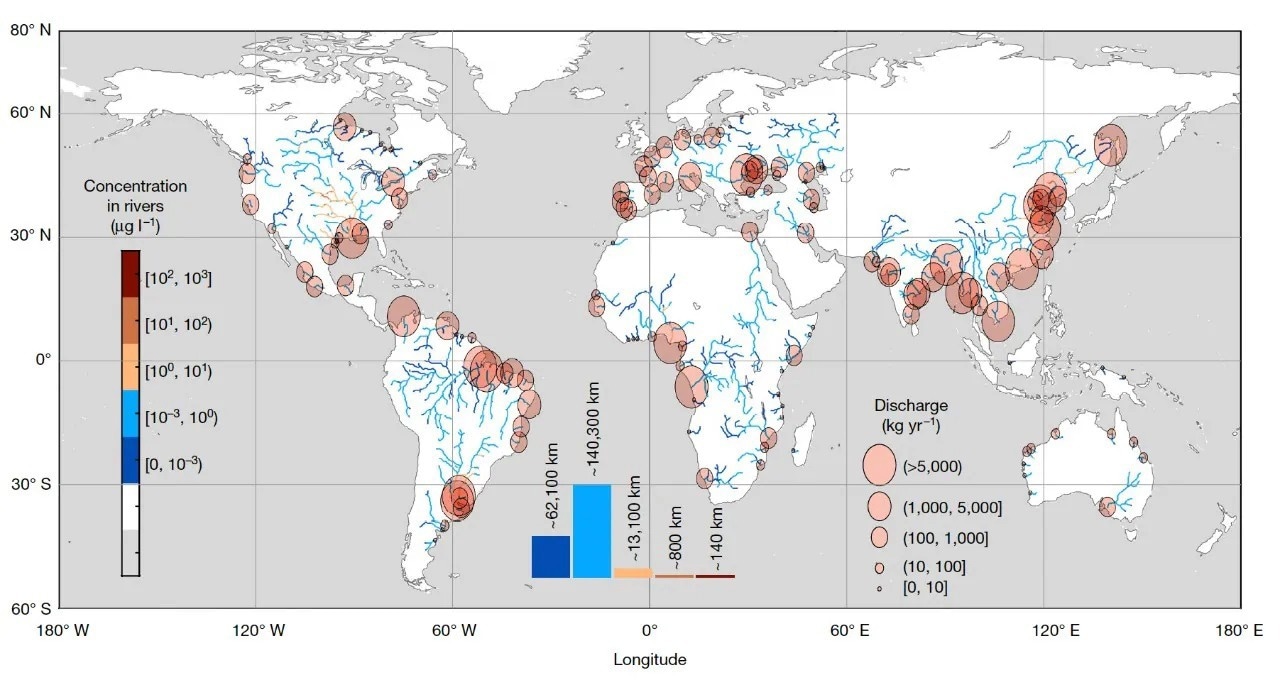A recent study has shown that after the initial agricultural application, the chemical odyssey pesticides embark upon with environmental consequences for a variety of ecosystems. This study was headed by the University of Sydney and published on July 13th, 2023, in Nature.
 Pesticide concentration in rivers and discharge to oceans. Image Credit: Associate Professor Federico Maggi, University of Sydney, Dr. Francesco Tabiella, United Nations and Dr. Fiona Tang, Monash University.
Pesticide concentration in rivers and discharge to oceans. Image Credit: Associate Professor Federico Maggi, University of Sydney, Dr. Francesco Tabiella, United Nations and Dr. Fiona Tang, Monash University.
Approximately three million tonnes of agricultural pesticides are utilized throughout the world annually. However, only little is known about where or in which environments these chemicals end up after their initial use.
An international research study published on July 13th, 2023, in Nature, which examined the geographic distribution of 92 of the most commonly employed agricultural pesticides, identified that around 70,000 tonnes of likely toxic chemicals percolate into aquifers annually, affecting freshwater resources and ecosystems.
Our study has revealed that pesticides wander far from their original source. In many cases, these chemicals end up a long way downstream and often, though in much smaller amounts, all the way to the ocean.
Federico Maggi, Study Lead Author and Associate Professor, School of Civil Engineering, University of Sydney
The study revealed that around 80% of applied pesticides degrade into byproducts or daughter molecules in the soil surrounding crops.
This degradation of pesticides often occurs as a ‘cascade’ of molecules into the surrounding environment, which can persist in the environment for a long time and can be just as harmful as the parent molecule or applied pesticide. One such example is glyphosate. Although it is highly degradable, it breaks down into a molecule known as AMPA that is both highly persistent and toxic.
Federico Maggi, Study Lead Author and Associate Professor, School of Civil Engineering, University of Sydney
Although the research determined that just a fraction of pesticides come into river systems upon field application, once in the water a majority of the active ingredients end up in ocean, with likely negative effects on coral reefs and marine wildlife. This puts the very basis of freshwater and marine food chains at risk.
“On paper, 0.1 percent leaching into fresh waterways might not sound like much,” adds Associate Professor Maggi. “But it only takes a tiny amount of pesticides to have a negative impact on the environment.”
The research revealed that 730 tons of pesticides end up in rivers annually, with around 13,000 km of rivers reaching chemical concentrations over safety limits for numerous invertebrates and aquatic plants, with scarcely comprehended consequences on the ecosystems or rivers.
“Just because we don’t see pesticide residues in soil and water doesn’t mean they’re not there, impacting critical systems on land, rivers, and oceans,” states Dr. Fiona Tang, who is a lecturer in water engineering at Monash University and paper co-author.
We must urgently adopt sustainable management strategies to promote reductions in field applications of harmful pesticides and set in place systems to effectively monitor their use under the 2030 Sustainable Development Agenda.
Dr. Francesco Tubiello, Study Co-Author and Senior Environmental Statistician, Food and Agriculture Organisation
The study group employed a huge collection of publicly accessible geospatial information to perform the study.
Nevertheless, the authors state the paper is a conventional estimate as not all pesticides were added to the analysis. They did not examine legacy pesticides and those utilized in aquaculture, public spaces, and private dwellings—which means the threat exposure of people and the environment to these chemicals could be larger.
Associate Professor Maggi co-authored a separate paper in Nature Ecology and Evolution highlighting suggestions to minimize the use of pesticides, alongside calling for a dependable set of indicators and enhanced monitoring.
He and the paper’s co-authors debate that targets for minimizing pesticide pollution needs to be concentrated on lowering risk, alongside minimizing toxicity and amounts, as some organisms are at high threat from very harmful pesticides, even while used in meager amounts.
“It is important that national authorities disclose statistics on the use of agricultural inputs, be they fertilizers or pesticides, given the effect they have on the environment and ecosystem service,” he adds.
Associate Professor Maggi said an international minimization of pesticide use at the same time retaining food security was feasible as long as such initiatives were developed and implemented in consultation with food producers.
“Globally, there is a lot of room to increase efficiencies and yield while still supporting an abundant food supply through new technology and modern crop management practices,” he added.
Journal Reference:
Maggi, F., et al. (2023) Agricultural pesticide land budget and river discharge to oceans. Nature. https://doi.org/10.1038/s41586-023-06296-x.